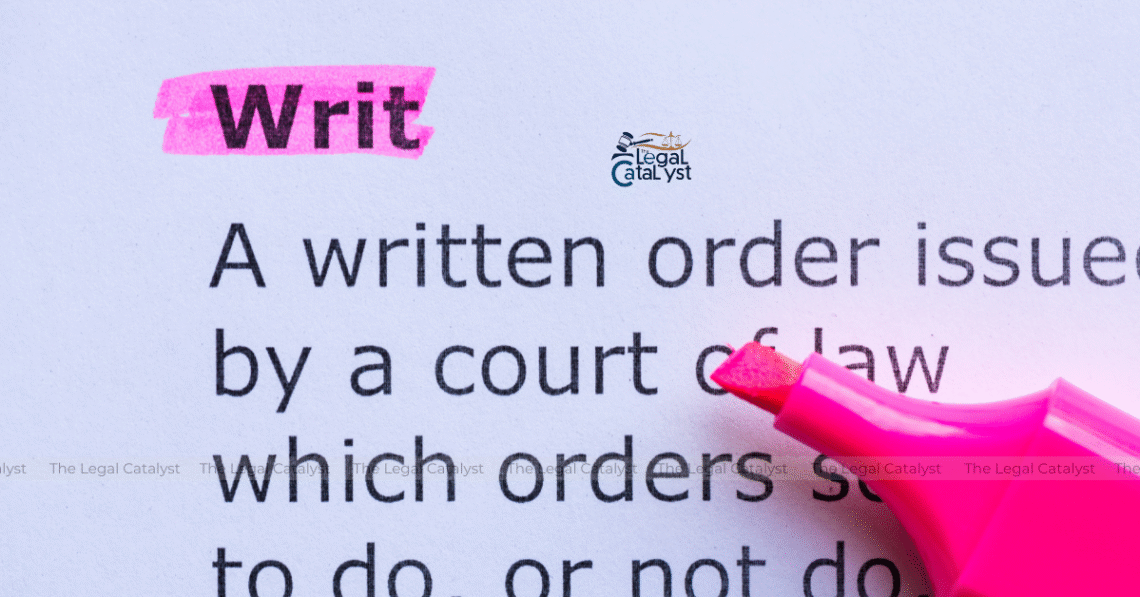Table of Contents
- Introduction
- Constitutional Basis of Writs
- Article 32 – Supreme Court
- Article 226 – High Courts
- Types of Writs in India
- 3.1. Habeas Corpus
- 3.2. Mandamus
- 3.3. Prohibition
- 3.4. Certiorari
- 3.5. Quo Warranto
- Comparison between Articles 32 and 226
- Significance of Writ Jurisdiction
- Conclusion
Introduction
The Constitution of India guarantees certain fundamental rights to its citizens under Part III. However, the mere existence of these rights would be meaningless unless there is an effective mechanism for their enforcement. To ensure this, the Constitution empowers the Supreme Court and High Courts to issue writs. These writs serve as powerful judicial remedies. They counter unlawful acts of the State. This process safeguards individual liberty and upholds the rule of law.
The power to issue writs ensures the protection of fundamental rights. It also serves as a check on administrative actions. Article 32 of the Constitution vests this power in the Supreme Court, while Article 226 grants it to the High Courts. This reflects Dr. B.R. Ambedkar’s assertion that Article 32 is the “heart and soul” of the Constitution.
Constitutional Basis of Writs
- Article 32: Empowers the Supreme Court to issue writs for the enforcement of fundamental rights. Citizens can directly approach the Court when their rights are violated.
- Article 226: Empowers the High Courts to issue writs not only for enforcement of fundamental rights. They can also issue writs for “any other purpose.” This makes its jurisdiction broader than that of the Supreme Court.
Thus, writ jurisdiction ensures both the supremacy of the Constitution and the accountability of State authorities.
Also Read- Media Trials in India: Freedom of Press or a Threat to Fair Trial?
Types of Writs in India
The Constitution recognizes five types of writs, borrowed from English law. Each writ serves a specific function and protects citizens against different forms of illegality.
1. Habeas Corpus – “You may have the body”
- The writ of habeas corpus is a safeguard against unlawful detention. It commands the detaining authority to produce the detained person before the court and justify the detention. If the detention is found illegal, the person must be released.
- Purpose: To protect personal liberty against arbitrary arrest or detention.
- Who can file? The detainee himself, or any person on his behalf.
- Limitations: Cannot be issued when detention is lawful, under contempt of court, or preventive detention validly authorized by law.
- Case law:
- Kanu Sanyal v. District Magistrate, Darjeeling (1973): The Court held that the writ is concerned with the legality of detention and not the production of the body alone.
- ADM Jabalpur v. Shivkant Shukla (1976): During Emergency, the Supreme Court controversially held that habeas corpus was not available. This decision was later overruled in Justice K.S. Puttaswamy v. Union of India (2017), reaffirming liberty as inviolable.

2. Mandamus – “We Command”
- This writ is issued to direct a public authority, tribunal, or government body to perform a duty imposed by law.
- Purpose: To prevent inaction or failure of duty by public officials.
- Limitations: Cannot be issued against private individuals, President, Governors, or for discretionary functions.
- Case law:
- Praga Tools Corporation v. C.A. Imanual (1969): Mandamus cannot be issued against a private company.
- Mani Subrat Jain v. State of Haryana (1977): Mandamus can be issued only when a legal right is established.

3. Prohibition – “To Forbid”
- Issued by a higher court to a lower court or tribunal, prohibiting it from exceeding its jurisdiction or acting contrary to law.
- Purpose: To ensure judicial bodies act within their prescribed limits.
- Case law:
- East India Commercial Co. v. Collector of Customs (1962): The writ of prohibition was issued to restrain authorities from acting beyond jurisdiction.

4. Certiorari – “To be Certified”
- Issued by a higher court to a lower court or tribunal, quashing its order or decision if it has acted without jurisdiction, exceeded jurisdiction, or violated natural justice.
- Purpose: Correcting errors of jurisdiction or law.
- Case law:
- Hari Vishnu Kamath v. Ahmad Ishaque (1955): The Court explained that certiorari corrects errors apparent on the face of the record.
- State of U.P. v. Mohammad Nooh (1958): Certiorari can be issued even when an alternative remedy exists, in exceptional cases.

5. Quo Warranto – “By What Authority”
- This writ questions the legality of a person’s claim to a public office. If the person is found to be occupying the office without valid authority, they can be removed.
- Purpose: To prevent unlawful occupation of public offices.
- Who can apply? Any person, even if not personally aggrieved.
- Case law:
- University of Mysore v. Govinda Rao (1963): The Court clarified the scope of quo warranto, holding that it ensures public offices are not usurped unlawfully.

Also Read- Backlog of Judicial Cases in India: A Looming Crisis Demanding Urgent Action
Comparison of Articles 32 and 226
- Supreme Court (Art. 32): Can issue writs only for enforcement of fundamental rights.
- High Courts (Art. 226): Can issue writs for fundamental rights as well as other legal rights.
- Wider scope of High Courts: Article 226 is broader, though Article 32 is itself a fundamental right.
Significance of Writ Jurisdiction
- Ensures rule of law and accountability of State authorities.
- Protects individual liberty and fundamental rights.
- Acts as a check on arbitrary exercise of power.
- Empowers citizens to directly approach higher judiciary against injustice.
Conclusion
The writ jurisdiction under Articles 32 and 226 forms the cornerstone of India’s constitutional democracy. It transforms the fundamental rights from being abstract principles into enforceable legal remedies. While the Supreme Court safeguards rights at the national level, High Courts serve as accessible guardians for individuals at the state level. The five writs—habeas corpus, mandamus, prohibition, certiorari, and quo warranto—provide the judiciary with flexible remedies. They allow the judiciary to meet diverse situations of injustice. Through their evolving interpretation, the courts have reinforced constitutional supremacy, preserved personal liberty, and ensured that no authority is above the law.
Connect with us on Instagram – X – LinkedIn for daily updates, quizzes, and other materials





